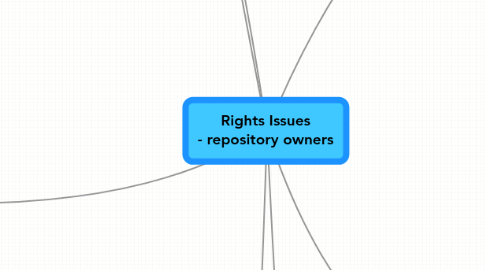
1. Licensing schemes
1.1. Market place
1.1.1. Metadata
1.1.1.1. Free
1.1.1.2. For sale
1.1.2. Products (contents)
1.1.2.1. Granularity
1.1.2.2. Digital media
1.1.2.2.1. Estream
1.1.2.2.2. CFU online
1.1.2.2.3. Kiosque numérique de l'éducation
1.1.2.2.4. Canal numérique des savoirs
1.2. Adds complexity
1.2.1. May help users
1.3. Business models
1.3.1. B to B
1.3.1.1. Authentification systems
1.3.2. B to P
1.3.2.1. Credit card payment
1.4. Examples
1.4.1. Contracts
1.4.1.1. with publishers
1.4.1.2. with ministerial institutions
1.4.2. Subscriptions
1.4.2.1. community based
1.4.3. Austria
1.4.3.1. SBX - SchoolBook Extra
1.4.3.1.1. student card
1.4.4. Creative commons
1.4.4.1. Logos
1.4.4.2. Anglosaxon rights system
1.4.5. IVINURS
1.5. Is Creative Commons the de facto standard for content licenses?
1.5.1. Positive: High Recognition
1.5.2. Negative: Amereocentric
1.6. Training
1.6.1. teachers
2. Monitoring copyright infringements
2.1. Who should monitor copyright infringements?
2.1.1. Managers of the repository
2.1.2. Community of users
2.2. How to prevent copyright infringements?
2.2.1. Disclaimers and agreements
2.2.1.1. Teachers' TV
2.2.1.2. Notice and takedown policies
2.2.1.2.1. British Library
2.2.1.2.2. JORUM
2.2.2. Automatic tools
2.2.2.1. Plagiarism scanners (software)
2.2.2.1.1. Example
2.2.3. Pre-moderating submitted content before it is published
2.2.4. Physical inspection on copyright infringements
2.2.4.1. Paper copies of digital materials
2.3. How to report copyright infringements?
2.3.1. Flagging
2.3.1.1. YouTube
2.3.2. Reporting form
2.3.2.1. Example
2.3.3. E-mail
2.3.3.1. Eample
2.3.4. Mail or fax
2.3.4.1. Example
2.4. General questions
2.4.1. Why monitor copyright infringements?
2.4.1.1. Increases liability
2.4.2. What are the types of copyright infringements?
2.4.2.1. Adding copyrighted content
2.4.2.2. Adding open content with wrong license
2.4.3. What are the problems with monitoring copyright infringements?
2.4.3.1. Costly
2.4.3.2. Is it efficient enough?
3. Developing guidelines to licensors
3.1. Principles
3.1.1. Ongoing policy dialogue
3.1.1.1. Repository owner
3.1.1.2. Contributors
3.1.1.3. Users (downloaders)
3.1.2. Infringement of guidelines
3.1.3. Administration
3.1.3.1. Policy
3.1.3.2. Who creates these guidelines?
3.1.3.2.1. Quality Control Issues
3.1.3.3. Staff
3.1.3.4. Legal advice
3.2. Individuals
3.2.1. Toolkit
3.2.1.1. Who owns copyright?
3.2.1.1.1. All owned by contributor
3.2.1.1.2. Some 3rd party material
3.2.1.2. Choose criteria for licence
3.2.1.2.1. attribution
3.2.1.2.2. commercial or not
3.2.1.2.3. derivatives permitted or not
3.2.1.3. Advise appropriate licence
3.2.1.3.1. Creative Commons
3.2.1.3.2. Other licences
3.2.1.4. Examples
3.2.1.4.1. Jorum
3.2.1.4.2. Creative Commons
3.2.1.4.3. UK Common Information Environment
3.2.1.4.4. AEShareNet
3.2.1.4.5. GNU Free Documentation License
3.2.1.4.6. LeMill
3.3. Organizations
3.3.1. Do you have your own licence?
3.3.2. Can you use a "common" licence?
3.4. Pre-moderating submitted content before it is published
4. Digital Rights Management
4.1. Management of Rights
4.1.1. Standards and Interoperability
4.1.2. Metadata
4.1.2.1. Rights Holder Information
4.1.2.1.1. Author
4.1.2.1.2. Publisher
4.1.2.2. Contract Information
4.1.2.2.1. Legal Framework
4.1.2.3. type of content
4.1.2.3.1. Different technical formats
4.1.2.3.2. granularity
4.1.2.4. use of content
4.1.2.4.1. B2B
4.1.2.4.2. B2C
4.1.2.5. User Profile
4.1.2.5.1. B2B
4.1.2.5.2. B2C
4.1.3. Technologies for controlling DRM
4.1.3.1. Locking out Technology
4.1.3.1.1. Licence Systems
4.1.3.2. Features for embedding DRM, making it not erasable, ...
4.1.3.3. Updating the rights information over time
4.1.4. Examples
4.1.4.1. JISC
5. User Interface issues
5.1. How should copyright restricted media be searchable/visible
5.1.1. role based
5.1.1.1. moral issues
5.1.1.2. legal issues
5.2. Metadata field for right issues must be compulsory!!!
5.2.1. disclaimers for user provided metadata
5.2.2. who is responsible for uploading illegal media content?
5.2.3. clear right issues by time of upload
5.2.4. filter search by licence
5.3. different legal situations in different countries
5.3.1. pre-filter resources by editor
5.3.2. "post filtering" recourses
5.3.2.1. users 'flag' illegally uploaded content
5.3.2.2. editors remove illegally uploaded content
5.4. collective metadata
6. Relevant policies and initiatives
6.1. free governmental
6.1.1. Policy to encourage teachers to publish
6.1.2. EU-wide policy for access
6.1.3. National resources
6.2. free in community
6.3. commercial
6.3.1. Two-way open access/usage w publishers
6.4. education of content creators
6.4.1. arrangement of learning objects
6.4.2. content reuse/restructuring
6.5. Policy for IP ownership of both metadata + object
6.6. repositories
6.6.1. repository is part of VLE
6.6.2. repository is VLE independent
7. Risk Management Strategies
7.1. Legal Analysis
7.1.1. Copyright
7.1.2. Data Protection/Privacy
7.1.3. Database Directive
7.1.4. Jurisdiction
7.1.5. Criminal Law
7.1.6. Content Provider Liability
7.2. Monitoring
7.2.1. Spam
7.2.2. Abuse
7.2.3. Content
7.3. Identity of Users
7.3.1. Define uploader
7.3.2. Define downloader
7.3.3. Identity theft
7.3.4. Quality Control
7.4. Logging users
7.4.1. Control v Privacy
7.5. Access to databse
7.6. Rules for use
7.6.1. Uploader/Publisher
7.6.2. Downloader
7.6.3. Re-use & Remix
7.6.4. Citation Recommendations
7.7. Technical Measures to secure content
7.7.1. Watermarks
7.7.2. DRM
7.7.3. Digital Signatures
7.8. Response strategies
7.8.1. Legal
7.8.1.1. Legal Umbrella Protection by the ministry for teachers
7.8.1.2. Legal waivers
7.8.2. Administrative
7.8.3. Technical
